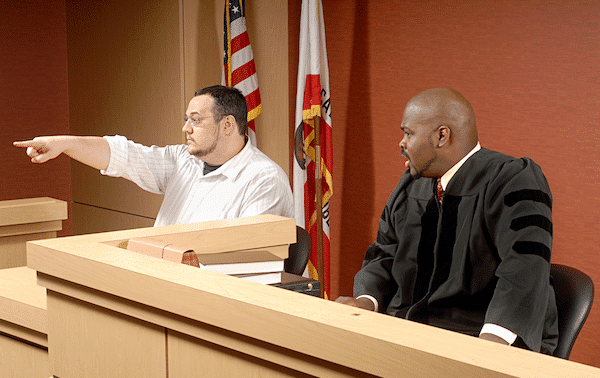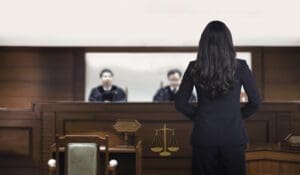Most civil cases, especially those involving pro se litigants, don’t make it to trial. The fact that your case has says a lot about you. First, kudos on jumping over multiple hurdles to stay in the game. It’s showtime. You have spent months, maybe even years, working towards this moment. What do you do now?
The good news is that by the time you get to trial, you have attended a number of hearings. So you’re familiar with court protocol. Evidentiary hearings, in fact, are mini previews for the trial. Though a trial is a step up from hearings, there are many similarities. Court rules and protocols you’ve used up to this point still apply. In the olden days, say 2019, you might have been able to attend live trials to get the lay of the land to gather more intelligence. Now, due to COVID-19, you have to get what you can online. Below, we’ll present pointers to help you with that.
Review and Make Notes
In litigation, success is often determined by the work you do outside the courtroom. Here’s what to do before trial.
- Prepare for one or more days of witness testimony and evidence presentation that will end in a final judgment.
- Just as you reviewed all necessary documents before hearings, do the same now. If you have a trial notebook, you’re ahead of the game. Use it and keep it updated.
- Review your case strategy to determine key talking points, facts you must prove, the evidence you need to present at trial, and when you need to present that evidence.
- Write talking points on notes.
Ready Evidence for Trial
Evidence can be documents, photographs, email, transcripts, and other things. Below are pointers for getting your evidence ready.
- Make notes about each piece of evidence that you plan to use during the trial. These are your exhibits.
- Your note for each exhibit should explain why it is relevant, in case the judge asks.
- Place exhibits in the order you wish to present them.
- During trial, place exhibits where they are easy for you to grab.
- For a real-time trial, make 3 copies of all of the documents you wish to present at trial–one for you, one for the judge, and one for your opponent.
- Online, follow your court’s process for distributing copies of documents.
- If the clerk does not process exhibits, you should label and number them with “Exhibit A”, “Exhibit B”, etc.
Understand Jury Selection (Voir Dire)
- In a jury trial, questioning potential jurors comes first. Here’s what should happen during voir dire.The judge will introduce the parties to prospective jurors and make a brief statement.
- The parties and judge will then ask a series of questions that were agreed on in the pre-trial process. The questions are designed to see if jurors are ready to render a fair judgment.
- Your goals are to keep the jurors that may be beneficial or fair to you and strike those that may be biased.
Make an Opening Statement
Now, it’s time for opening statements. Here’s what should happen.
- The plaintiff goes first.
- The opening statement can be as simple as stating your name and why you’re in court, or it could present the facts of the case in a concise and compelling way.
- The statement should provide an overview of the case.
- After the plaintiff is done, the defendant will make an opening statement and assert relevant defenses.
- If you’re the defendant, don’t repeat the facts the plaintiff stated. Rather, highlight differences or points of disagreement you have with the plaintiff’s facts.
- This back-and-forth dialogue is at the heart of the adversarial legal system. It continues through the trial as the parties present their evidence and examine the witnesses.
Present Trial Evidence
After the opening statements, both sides will call witnesses and present evidence. Below is an overview.
- The plaintiff goes first. This is called the case-in-chief.
- When you’re ready to call a witness, you can say, “Your Honor, I call my first witness”…
- The court will swear each witness in and record their testimony.
- This is followed by the direct examination by the plaintiff and cross-examination by the defendant. If you need to approach the bench or the witness during the trial, ask for the judge’s permission first.
- Evidence must be admissible (relevant and trustworthy). So the person wanting the evidence admitted, may be required to lay a factual foundation for it by using a witness to establish its authenticity.
- If the opposing party challenges a piece of evidence, defend it by repeating why it’s vital to your case.
- If you object to evidence entered by the opposing party, explain why it is not relevant or violates the rules of evidence.
Closing
Once both parties are done with their cases in chief, the parties make closing statements. Here’s how it goes.
- The plaintiff will make his or her closing argument.
- The defendant will then make a closing argument.
- Since the plaintiff has the burden of proof, he will have a chance for a rebuttal of the defendant’s closing argument.
- If there is no jury, a judge will render a verdict and judgment.
- If the case was tried by a jury, the jury renders the verdict, and the judge delivers a judgment.
It’s over. While trials can certainly reach a boiling point, most don’t. The parties are there to present their side of the case in a controlled setting. There are rules, processes, and procedures. Make your best attempt to get your evidence heard within these guidelines. Then rest your case. No need to boil.



